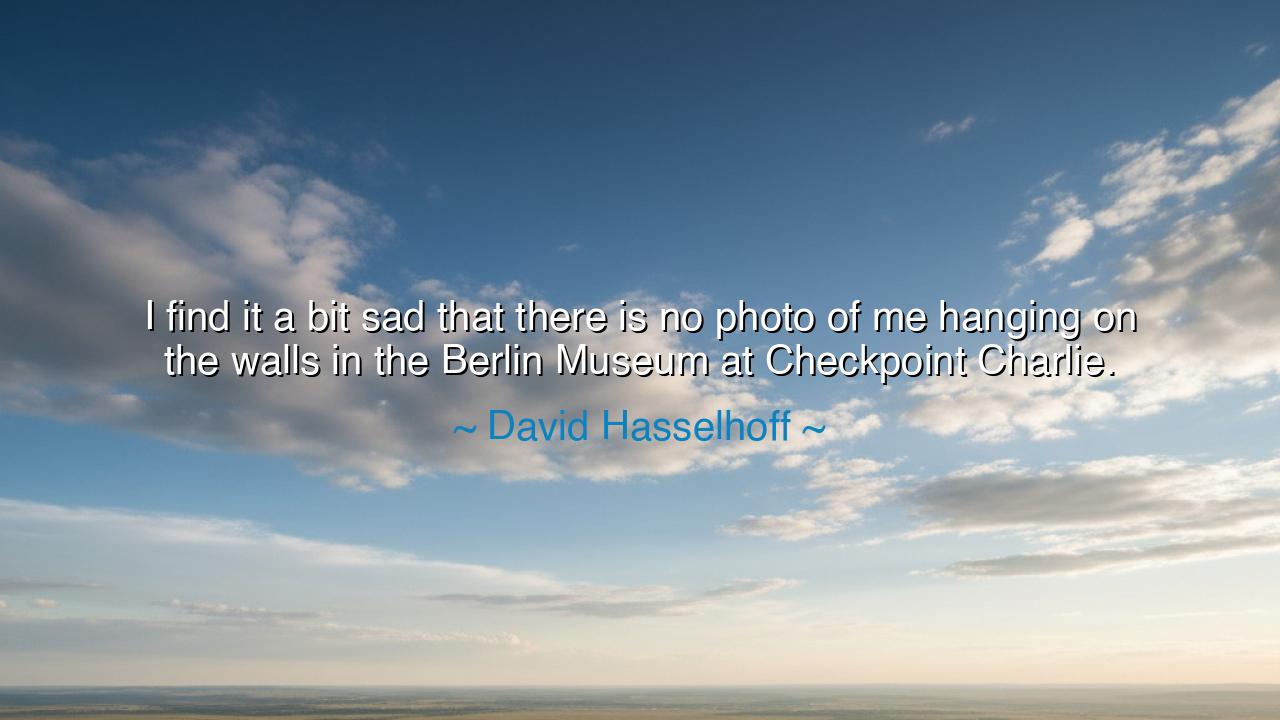
I find it a bit sad that there is no photo of me hanging on the
I find it a bit sad that there is no photo of me hanging on the walls in the Berlin Museum at Checkpoint Charlie.






The words of David Hasselhoff, “I find it a bit sad that there is no photo of me hanging on the walls in the Berlin Museum at Checkpoint Charlie,” speak not only of a man reflecting on his role in history, but of the deep human desire for remembrance and recognition. Though said with a touch of humor, his remark carries the weight of truth: he stood on a stage in 1989, singing “Looking for Freedom” to the crowds gathered at the Berlin Wall, at the very moment when East and West Germany were being joined again. To him, his presence and his song became part of the memory of freedom’s triumph. And yet, to walk through a museum of history and find no trace of himself is to feel the sting of invisibility, as if his contribution has been cast into shadow.
The origin of this feeling lies in the symbolic role Hasselhoff played in the fall of the Wall. While he was not the architect of political change, nor the hand that tore down the barriers, his song became an anthem that resonated with the spirit of the people. In that moment, he was not merely an entertainer but a vessel for collective hope. His words reveal the tension between official history—what is recorded in museums, books, and monuments—and living memory—what people themselves remember, sing, and carry in their hearts.
This is an ancient tension. Consider Homer’s heroes, whose deeds at Troy lived not in the inscriptions of stone, but in the songs of the poets. How many warriors fought bravely yet were never remembered because their names were not sung? Hasselhoff, like those forgotten warriors, touches upon the sorrow of being left outside the formal record, even though in the hearts of many, his song was part of the victory. History often chooses a few names for its walls, while countless others fade, and this is the sadness he confesses.
Yet within this sadness lies also a kind of triumph. For while his photo may not hang in Checkpoint Charlie, his voice did echo across Berlin at a turning point in history, and his performance is remembered by those who were there. The absence in the museum does not erase the presence in the people’s hearts. This reminds us that history is not only written in institutions, but also carried in the spirit of communities. Recognition in stone is one kind of immortality; recognition in memory is another.
Hasselhoff’s words also unveil the universal longing of the human spirit: to know that our contributions, however small or great, are seen and remembered. We each desire that the efforts we make for others, the sacrifices we give, the songs we sing, are not forgotten. His sadness is not vanity alone; it is a mirror of the truth that to be forgotten is one of humanity’s deepest fears.
The lesson for us is profound: do not measure your worth only by recognition on walls of stone or in the halls of institutions. The truest legacy is not in plaques or photographs, but in the lives we touch, in the spirits we lift, in the freedom or joy we bring to others. Just as Hasselhoff’s song gave strength in a pivotal moment, so too can our words, our actions, and our presence shape history in quiet, unseen ways.
Practically, this means we should live not for monuments but for meaning. If recognition comes, let it be accepted with gratitude. If it does not, let us not despair. For in the end, what endures is not whether our image hangs in a museum, but whether our lives inspired others to hope, to persevere, to break their own walls.
Thus, the words of David Hasselhoff, tinged with humor and sadness, carry ancient wisdom: that human recognition is fleeting, but the power of a moment lived in truth is eternal. Let us not live only to be remembered in stone, but to be remembered in spirit—for the songs sung in the hearts of people are the truest monuments of all.






AAdministratorAdministrator
Welcome, honored guests. Please leave a comment, we will respond soon